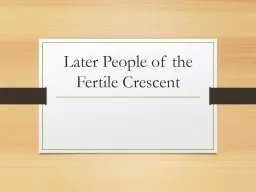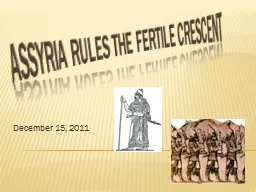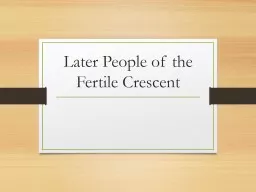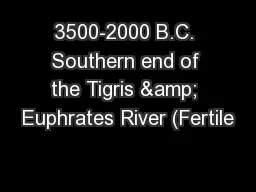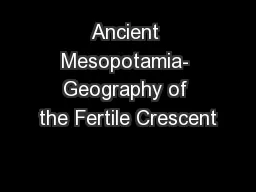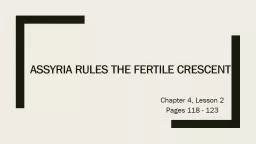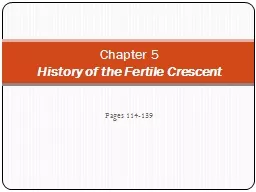PPT-Later People of the Fertile Crescent
Author : natalia-silvester | Published Date : 2017-09-21
Invasions of Mesopotamia Several other civilizations also developed in and around the Fertile Crescent As their armies battled each other for fertile land control
Presentation Embed Code
Download Presentation
Download Presentation The PPT/PDF document "Later People of the Fertile Crescent" is the property of its rightful owner. Permission is granted to download and print the materials on this website for personal, non-commercial use only, and to display it on your personal computer provided you do not modify the materials and that you retain all copyright notices contained in the materials. By downloading content from our website, you accept the terms of this agreement.
Later People of the Fertile Crescent: Transcript
Invasions of Mesopotamia Several other civilizations also developed in and around the Fertile Crescent As their armies battled each other for fertile land control of the region passed from one empire to another. Mesopotamia. Humans lived as . nomads for tens of . thousands of years . before slowly . settling down in . various parts of the . world. . Nomads are . people who have no . permanent home and . travel in search of food and safety. . December . 15, 2011. Time Line. Sargon. 2350 – 2150 B.C.. Hammurabi (Babylonian Empire). 2000 – 1750 B.C. Future 2011….. Assyrians . Present time. Assyrian Empire. A Mighty military MACHINE . A Powerful Army. 7000-5000 B.C.. 7.1.1 Identify and compare the rise of early agricultural river valley civilization in Africa and Asia.. 7.1.3. Trace steps in the development of written language, including the evolution of Sumerian cuneiform, Egyptian hieroglyphics, and Chinese calligraphy.. by . Conan . Amituanai. 8 Key Stages . There are 8 key stages of the moon that appear during its rotation around the earth.. 1. First Quarter. 2. Waxing Crescent. 3. New Moon. 4. Waning Crescent . 5. Third Quarter. PowerPoints. are reduced versions.. In order to upload them onto . Teacherspayteachers. I’ve had to remove the embedded movie files and other media.. If you want the full copies please send me an email so I can send you a download link free of charge.. Invasions of Mesopotamia. Several other civilizations also developed in and around the Fertile Crescent. As their armies battled each other for fertile land, control of the region passed from one empire to another.. Crescent). The Sumerians. First people known to live in the Fertile Crescent.. They farmed and raised cattle. Built large cities. They invented the arch. The Ziggurat a large stepped pyramid temple. ”. Madison Perry & Elizabeth Troy. What is it?. “Fertile Crescent is regarded as the birthplace of agriculture, urbanization, writing, trade, science, history, and organized religions.”. A region in the Middle East that curves (hence crescent) through southern Iraq, Syria, Lebanon, Jordan, Israel, and northern Egypt.. 6. th. . Grade Social Studies. Chapter 5 Lesson 1 in the World Text. The Big Picture. Around 4000 BC Egyptian farming communities were growing along the Nile River.. Another civilization was also developing in . Chapter 4, Lesson 2. Pages 118 - 123. Objectives. Describe the rise and fall of the Assyrian Empire in the Fertile Crescent. Describe Assyrian innovations in building and ruling an empire. Trace the rise and fall of the Assyrian Empire’s successor - the Chaldean Empire. History of the Fertile Crescent. The Main Idea. The rivers of Southwest Asia supported the growth of civilization. New farming techniques led to the growth of cities. .. The BIG Idea. The valleys of the Tigris and Euphrates rivers were the site of the world’s first civilizations.. La gamme de thé MORPHEE vise toute générations recherchant le sommeil paisible tant désiré et non procuré par tout types de médicaments. Essentiellement composé de feuille de morphine, ce thé vous assurera d’un rétablissement digne d’un voyage sur . 4 Key features The TERA system includes an integrated portal with GIS capabilities. Most functionalities used can be directly accessed from the interface, allowing the user to perform important tasks Guide. Part 1. (Short Answer Test). Civilization. a group of people living together who have organized systems of government, education, religion, and a social structure. Systems of Government. Education.
Download Document
Here is the link to download the presentation.
"Later People of the Fertile Crescent"The content belongs to its owner. You may download and print it for personal use, without modification, and keep all copyright notices. By downloading, you agree to these terms.
Related Documents

